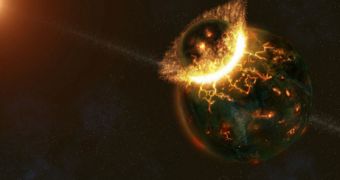The collision of the original Earth with another planet dimensioned similarly to Mars, which resulted in the creation of our large Moon, might have taken place later in the stages of solar system formation, new studies show. Because it is the most credible explanation of the Moon's birth - since other models cannot predict the formation of such a large body - the planetary collision scenario has now become largely accepted in the scientific community.
According to the previous theory, about 30 million years after the formation of the solar system, the original Earth collided with a protoplanetary body, having nearly the size of the planet Mars, that got ejected from its orbit. As a consequence of the enormous energy resulted in the impact, both bodies were destroyed in the process. Eventually, the gravitational field pulled together parts of the resulting debris to form the current planet, while the rest formed a magma disk around the Earth, pulled together by a common atmosphere. At the same time, the material orbiting in the close proximity of the Earth formed the biggest natural satellite in the solar system, relative to the size of the planet.
Computer simulations show that this scenario would have resulted in a moon having a composition formed of about 80 percent of material from the impactor, and further 20 percent ripped from the Earth during the collision.
However, Mathieu Touboul from the Swiss Federal Institute of Technology, argues instead that our moon must have formed out of material mostly resulted from the debris of the original planet, and, during the magma disk formation process, the two could have shared a metal vapor atmosphere. This implies that, by the time the planet and its moon were completely formed and drifting apart from each other, they could have had an identical chemical makeup.
Surprisingly enough, the new theory has been confirmed by new computer simulations which predict that such interactions are possible. Furthermore, this implies that our Moon is younger than previously thought.
In the early 1970s during the Apollo program, involving manned missions to the Moon, astronauts collected multiple rock samples, that had been on the surface for billions of years, without suffering extreme changes except for the action of solar wind. By analyzing their chemical composition and comparing them to some of the oldest rocks found on Earth, scientists could calculate the age of both bodies.
The samples returned by the Apollo program were studied especially with the hope of finding traces of a tungsten isotope, called tungsten-182 which is mainly obtained through the radioactive decay of the hafnium-182 isotope during its nine million years half-life period. Comparison of the amount of the tungsten isotope that resulted through the decay of the hafnium and the tungsten-184 which is created through a separate process could then give an idea on the age of the rocks brought back from the Moon, which would also indicate exactly when the magma formed a solid crust.
However, the effect of rocks lying billions of years on the surface of the Moon, being continuously bombarded with high amounts of radiation, made this dating method extremely difficult. Nevertheless, scientists were able to approximate that, in fact, the catastrophic collision that gave birth to our Moon might have taken place about 30 million years later than the previous theory predicted, meaning that its molten magma would have solidified about 120 million years after the formation of the solar system, which is quite a long time, related to the solar system's age.
The new findings quickly contradicted the computer simulations, which implied that the magma ocean should have formed a solid surface much faster; however, similar results suggesting that Mars also could have maintained a magma ocean for a longer time further back up the new findings.

 14 DAY TRIAL //
14 DAY TRIAL //